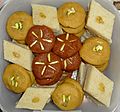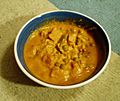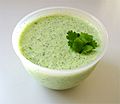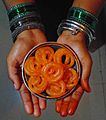Etah facts for kids
Quick facts for kids
Etah
|
|
|---|---|
|
City
|
|
| Country | |
| State | Uttar Pradesh |
| District | Etah |
| Founded by | King Dil sukh Rai bhadur |
| Government | |
| • Type | Municipal Corporation |
| • Body | Etah Municipal Corporation |
| Population
(2011)
|
|
| • Total | 131,023 |
| Languages | |
| • Official | Hindi |
| Time zone | UTC+5:30 (IST) |
| Vehicle registration | UP-82 |
Etah is a municipality city which is also the headquarters of Etah District of the Uttar Pradesh state in India. Etah district is part of the Aligarh Division and is located at the midpoint of the Delhi-Kanpur Highway (NH 91) known as GT Road. The nearest big cities are Aligarh and Agra.
Contents
History
The city lies in the cultural region of Braj and was a part of the Surasena Mahajanapada during the Vedic Age. It was later ruled over successively by larger kingdoms including the Mauryas, Guptas, Scythians, Kushans and Indo-Greeks, before falling into the hands of local Rajput rulers. There is a famous village named Malawan is also situated near etah.
It is the midpoint on the Kanpur-Delhi Highway. Historically, it is also known for being a centre of the Revolt of 1857.
In ancient times, Etah was called "Aintha" which means 'to respond aggressively' because Rajputs communnity lived here is violent in nature . According to local history and folklore, this name stemmed from an incident in which King of Awagarh went hunting in the forest with his two dogs. The dogs saw a fox and started barking and chasing it. The fox fled to protect itself from the King's dogs, but when it reached Etah, the fox turned and responded very aggressively to the King's dogs. The King was surprised by the behavioral change in the fox. So, he thought that this place must have something which made the fleeing fox change its attitude. Therefore, the place was called "Aintha", which later was mispronounced as "Etah".
Another story found in Vidya Bharti's book states the old name "Etah" as "Einta" due to a person lost here. In search of water, he dug into the land and his shoe struck a brick ("eint") which leads to the name "Einta" and later this word changed to "Etah".
Geography
Etah is located at 27°38′N 78°40′E / 27.63°N 78.67°E. It has an average elevation of 170 metres (557 feet).The upper and lower Ganga Canal flow through Etah.
Demographics
As of the 2011 census, Etah's urban agglomeration had a population of 131,023 with 69,446 males and 61,577 females. The literacy rate was 85.62%. 11,786 of the population are of scheduled castes, while 65 are of scheduled tribes. The local languages are Brajbhasha and Kannauji.
| Religions in Etah | ||||
|---|---|---|---|---|
| Religion | Percent | |||
| Hindus | 78.30% | |||
| Muslims | 17.92% | |||
| Jains | 2.80% | |||
| Others† | 0.6% | |||
| Distribution of religions †Includes Sikhs (0.2%), Buddhists (<0.2%). |
||||
Civic amenities
The master plan of the city (1984-2001) was created by the U.P. Town and Country Planning Department. The U.P. Jal Nigam is the body responsible for water supply, and electricity is provided by the Dakshinanchal Vidyut Vitran Nigam Ltd., the southern discom of the Uttar Pradesh state government.
A thermal power project of 1320 MW has been proposed at Malawan, approximately 15 km from Etah, and Ministry of Environment has cleared the project. Land acquisition work has been completed and construction is scheduled to be completed in 2021.
Culture
Etah lies in the cultural region of Braj. Etah is a developing city and has been the district headquarters since British rule. The Padav maidan (open field) is the name of a field used by the army, and every year this field is used for Ram-Lila at Dussehra in the months of September and October and for exhibitions from December to February.
Amir Khusro was born in Patiyali, Kasganj and is considered one of the best poets of Urdu.
Dress
The people of Etah dress in a variety of traditional and Western styles. Traditional styles of dress include colourful draped garments such as sari, dhoti or lungi and tailored clothes such as shalwar kameez and kurta-pyjama. Men often sport head gear like topi or pagri. Sherwani is a more formal male dress and is frequently worn along with chooridar on festive occasions. European-style trousers and shirts are also common.
Food
Etah's food consists of the cuisine prepared in the state of Uttar Pradesh, India. It consists of Mughlai cuisine and both vegetarian and non-vegetarian foods. Dum biryani, kababs, and kormas are some of the dishes made in this region.
-
Chicken curry with chapati
Transport
The opening of a railway line in Etah was done by the first president of India, Rajendra Prasad, in 1959, and the train runs from Etah to Tundla. The Etah–Agra Fort Passenger Special started running from Etah to Agra, when railway ministry approved the survey for direct trains to New Delhi, Agra and Aligarh.
Religion
Dargah Hazrat Makhdoom Abdul Ghafur Shah Safvi is situated at the holy gate. Hazrat was the Great Sufi of the silsila e chishtiya and safviya-khadimiya and Haji Mohammad Islam Safvi is the sajjada nashin of dargah sharif at present time.. The 148-year-old Kailash Mandir at Etah was built by King Dil Sukh Rai Bahadur. Noah Kera village was known for marriage of Lord Sri Krishna with Rukmini.. Bhooteshwar is a place for Hindu bodies to be cremated.
Economy
Agriculture and industry are the main source of economy.
Agriculture
Etah's primary economy is centred around agriculture. The area is situated between Ganga and Yamuna (Doaab) which is highly fertile (Alluvial soil). Farmers harvest three crops each year as irrigation is available year-round. Major agricultural products are rice, wheat, barley, jowar, bajra, and maize, and the soil is also suitable for the cultivation of tobacco.
See also
 In Spanish: Etah para niños
In Spanish: Etah para niños











